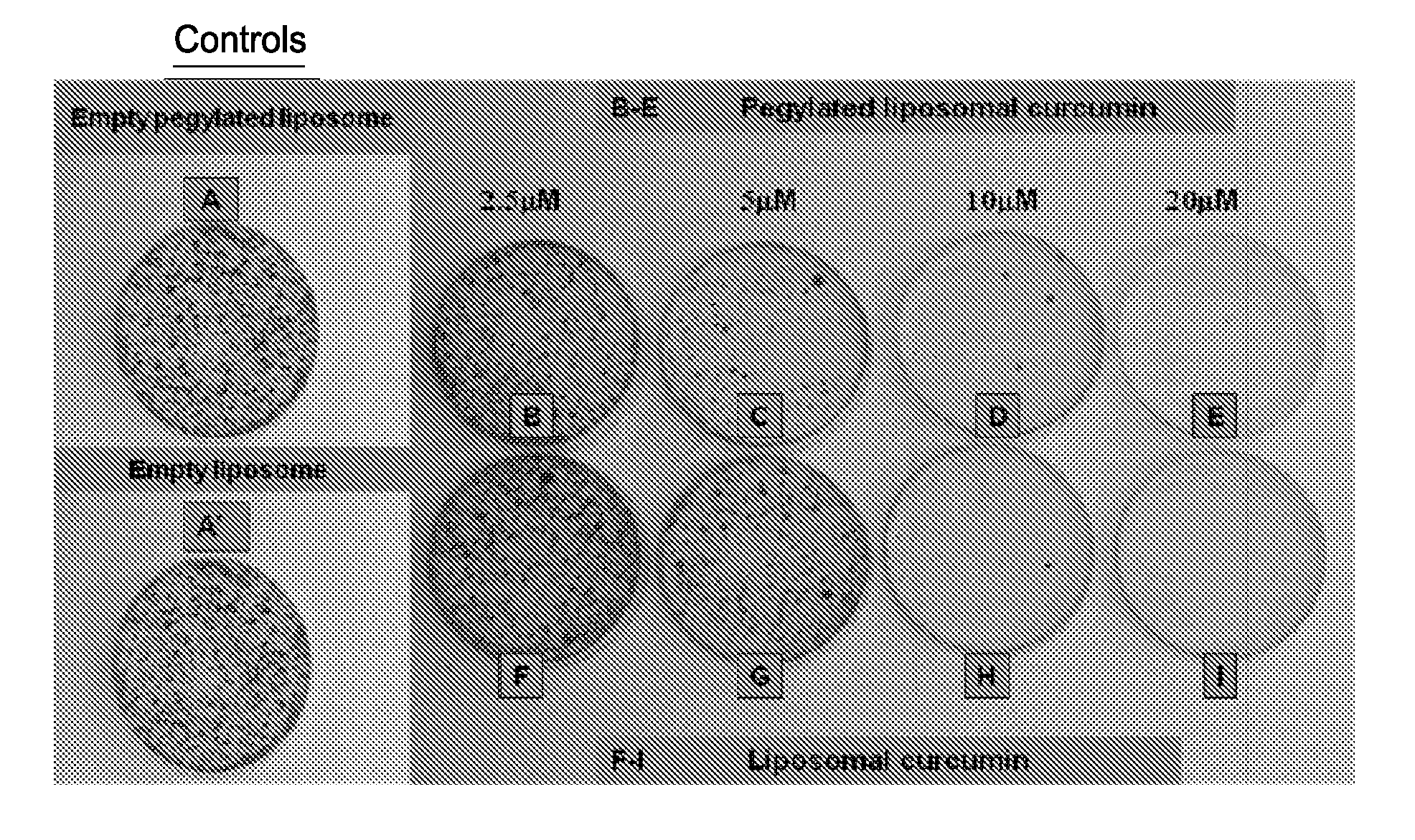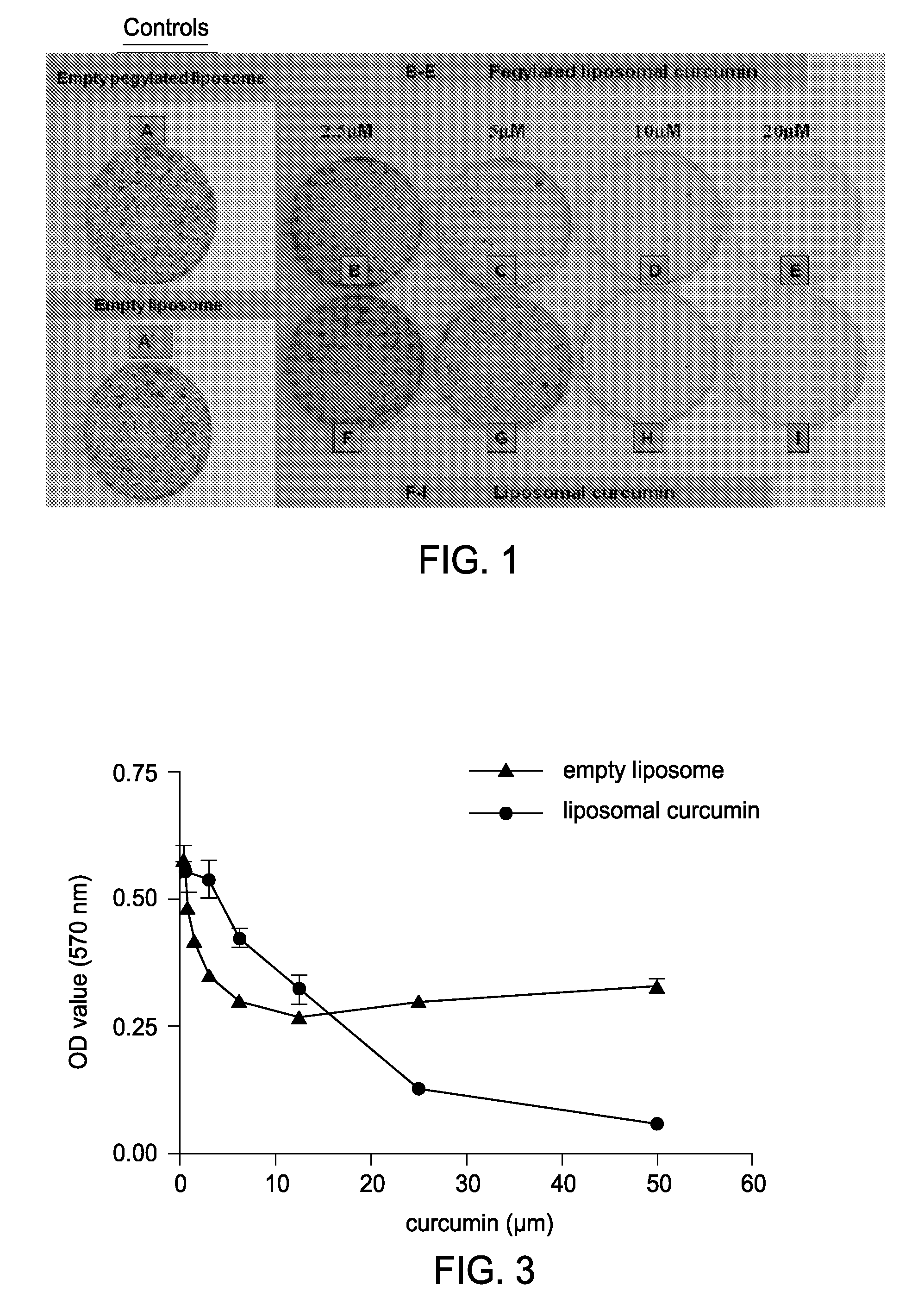Liposomal curcumin for treatment of neurofibromatosis
- Summary
- Abstract
- Description
- Claims
- Application Information
AI Technical Summary
Benefits of technology
Problems solved by technology
Method used
Image
Examples
example 1
[0110] Preparation of curcumin-containing liposomes. Liposomal curcumin was formulated using the following protocol. A phospholipid, 1,2-dimyristoyl-sn-glycero-3-phosphocholine (dimyristoylphosphocholine; DMPC) (Avanti Polar Lipids, Alabaster, Ala. 35007) was chosen for the liposomal formulation. The phospholipid was solubilized by dissolving 200 mg of DMPC in 10 ml of t-butanol (Fisher Scientific) and heating the mixture in a 37° C. water bath for 5 minutes. The solution was stored at −20° C. in a container that protected the solution from exposure to light.
[0111] Curcumin (Sigma) was solubilized by dissolving curcumin in DMSO to a final concentration of 50 mg / ml. The solution was also aliquoted and stored in a container that protected the solution from exposure to light.
[0112] To combine the phospholipid and curcumin solutions, 10 ml of DMPC in t-butanol, 0.4 ml curcumin in DMSO and 90 ml of t-butanol were mixed very well and aliquoted into small sterile glass vials containing 2...
example 2
[0114] Curcumin inhibits proliferation / survival of pancreatic cells. Seventy-two hours of exposure to free curcumin inhibited pancreatic cell growth of all five lines tested in a concentration-dependent manner. Controls were exposed to 0.1% v / v DMSO. Proliferation and survival of the pancreatic cells were assessed by MTT assay, a standard calorimetric assay used to measure cell survival and proliferation (Mosman, 1983). MTT (3-[4,5-c]methylthiazol-2-yl]-2,5-diphenyl tetrazolium bromide) is cleaved by living cells to yield a dark blue formazan product. The color is quantitated by spectrophotometer and reflects cellular proliferation and survival. As shown in FIGS. 1-5, pancreatic Bxpc-3, Capan-1, Capan-2, HS766-T and ASPC-1 cells were exposed to free curcumin in varying concentrations for a period of 72 hours. The control for each assay was exposed to 0.1% v / v DMSO.
example 3
[0115] Liposomal curcumin has equivalent or greater anti-proliferative effects than free curcumin. The inventors have examined the effect of free curcumin on the proliferation and survival of five pancreatic carcinoma cell lines (Bxpc-3, Capan-1, Capan-2, HS766T, and Aspc-1). The effects of liposomal curcumin were compared to those of liposomes alone, free curcumin, lyophilized free curcumin and liposomal curcumin. MTT proliferation / survival assay was performed after 72 hours of incubation.
[0116] Exposure to curcumin resulted in significant inhibition of proliferation and survival as assessed by MTT assay in all of these cell lines. FIGS. 5-10 show graphs of the results of the assays using Bxpc-3, Capan-1, Capan-2, HS766-1 and ASPC-1 cell lines, respectively. In the MTT proliferation / survival assay shown in FIGS. 5-10 the pancreatic cell lines were exposed to free curcumin, lyophilized free curcumin (lyophilized curcumin), liposomal curcumin or liposomes without curcumin (liposomes...
PUM
| Property | Measurement | Unit |
|---|---|---|
| Percent by mass | aaaaa | aaaaa |
| Dimensionless property | aaaaa | aaaaa |
| Dimensionless property | aaaaa | aaaaa |
Abstract
Description
Claims
Application Information
 Login to View More
Login to View More - R&D
- Intellectual Property
- Life Sciences
- Materials
- Tech Scout
- Unparalleled Data Quality
- Higher Quality Content
- 60% Fewer Hallucinations
Browse by: Latest US Patents, China's latest patents, Technical Efficacy Thesaurus, Application Domain, Technology Topic, Popular Technical Reports.
© 2025 PatSnap. All rights reserved.Legal|Privacy policy|Modern Slavery Act Transparency Statement|Sitemap|About US| Contact US: help@patsnap.com



